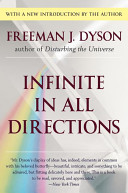Superstring Theory
It is time now to try to describe what a superstring really is. Here I run into the same difficulty which the geometer Euclid encountered 2,200 years ago. Euclid was trying to convey to his readers his idea of a geometrical point. For this purpose he gave his famous definition of a point: "A point is that which has no parts, or which has no magnitude." This definition would not be very helpful to somebody who was ignorant of geometry and wanted to understand what a point was. Euclid's notion of a point only becomes clear when one reads beyond the definition and sees how points are related to lines and planes and circles and spheres. A point has no existence by itself. It exists only as a part of the pattern of relationships which constitute the geometry of Euclid. This is what one means when one says that a point is a mathematical abstraction. The question, What is a point? has no satisfactory answer. Euclid's definition certainly does not answer it. The right way to ask the question is: How does the concept of a point fit into the logical structure of Euclid's geometry? This question is answered when one has understood Euclid's axioms and theorems. It cannot be answered by a definition. {17}
If I were to follow the example of Euclid and try to give a definition of a superstring, it would be something like this: "A superstring is a wiggly curve which moves in a ten-dimensional space-time of peculiar symmetry." Like Euclid's definition of a point, this tells us very little. It gives us only a misleading picture of a wiggly curve thrashing about in a dark room all by itself. In fact a superstring is never all by itself, just as a Euclidean point is never all by itself. The superstring theory has the ten-dimensional space-time filled with a seething mass of superstrings. The objects with which the theory deals are not individual superstrings but symmetry-groups of states in which superstrings may be distributed. The symmetry-groups are supposed to be observable. If the theory is successful, the symmetry-groups derived from the mathematics of superstrings will be found to be in correspondence with the symmetry-groups of fields and particles seen in the laboratory. The correspondence is still far from being established in detail. Witten's excitement arose from the fact that the theory passed several crucial tests which other theories had failed. To have found a theory of the universe which is not mathematically self-contradictory is already a considerable achievement.
Notes:
Folksonomies: science definition quantum physics superstring
Taxonomies:
/science/mathematics/geometry (0.746148)
/science/physics (0.399812)
/finance/grants, scholarships and financial aid/financial aid (0.250255)
Keywords:
Euclid (0.951151 (positive:0.366258)), point (0.833156 (positive:0.118283)), geometer Euclid (0.750463 (negative:-0.469684)), wiggly curve (0.737629 (negative:-0.921999)), ten-dimensional space-time (0.712586 (negative:-0.635840)), wiggly curve thrashing (0.709047 (negative:-0.921999)), definition (0.674057 (negative:-0.496890)), superstring (0.659438 (negative:-0.341299)), superstring theory (0.633486 (negative:-0.635840)), famous definition (0.619488 (neutral:0.000000)), individual superstrings (0.605642 (negative:-0.288078)), geometrical point (0.583566 (neutral:0.000000)), satisfactory answer (0.569263 (negative:-0.422485)), mathematical abstraction (0.568788 (positive:0.518286)), seething mass (0.560911 (negative:-0.635840)), peculiar symmetry (0.559679 (neutral:0.000000)), logical structure (0.557418 (positive:0.792542)), right way (0.557408 (positive:0.675464)), point fit (0.557087 (positive:0.792542)), considerable achievement (0.556555 (positive:0.238468)), Euclidean point (0.555362 (negative:-0.617615)), misleading picture (0.554990 (negative:-0.921999)), crucial tests (0.552013 (negative:-0.430377)), dark room (0.549272 (negative:-0.921999)), theory deals (0.538371 (negative:-0.288078)), question (0.509912 (positive:0.675464)), symmetry-groups (0.494129 (negative:-0.463691)), correspondence (0.457072 (neutral:0.000000)), geometry (0.451053 (negative:-0.606102)), ignorant (0.441733 (negative:-0.606102))
Entities:
Euclid:Person (0.899100 (negative:-0.121578)), superstrings:City (0.416041 (negative:-0.328302)), Witten:Person (0.148763 (negative:-0.430377)), 2,200 years:Quantity (0.148763 (neutral:0.000000))
Concepts:
Mathematics (0.965579): dbpedia | freebase | opencyc
Geometry (0.899989): dbpedia | freebase | opencyc
Euclidean geometry (0.804960): dbpedia | freebase
Axiom (0.700820): dbpedia | freebase
Euclid (0.671311): dbpedia | freebase | yago
String theory (0.651717): website | dbpedia | freebase
Pythagorean theorem (0.638178): dbpedia | freebase | yago
Euclid's Elements (0.585340): dbpedia | freebase | yago





